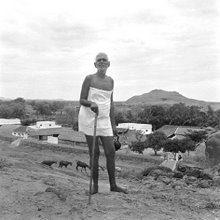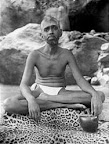VENKATARAMAN now came to be known as Brahmana Paradesi. In the Tamil region, Saivite non-
Brahmins used to take to sannyasa [?] and go about Arunachala in hundreds whereas such wandering Brahmin sannyasins were few. They came to be known as Brahmana Paradesis.
The new Paradesi took his place at a platform in the thousand pillared hall for his meditation. Winter was just approaching, the monsoon had not abated. He had no clothes either to spread on the floor or to cover himself with. He never sought people's company and even if any such company came his way he moved away. He sat silently, with his eyes shut. Even while walking about he never spoke to anyone. He never sought food from anyone and if anyone offered him food while he was wide awake, he would accept it. He abided in the Self, he held his senses captive and controlled his mind. He was enjoying the Kingdom of Yoga. This lad never sought anything. However, even if he left others alone, they would not leave him alone. For them he was an object of curiosity, or ridicule or blame but for a few, he was an object of respect. He was at a new place, helpless, unprotected ?
but was he unprotected really? His only refuge were the feet of Siva but that Siva never appeared before him!
This lad became the target of the local urchins who looked upon him as a madcap. Did not `Mad Seshadri' arrive at that town four years earlier? Just as they showered pebbles, or pieces of pots on Seshadri they did the same to this lad also. But they threw their missiles from a distance lest the `mad-man' retaliate. As a result, the missiles missed their target. But they disturbed his meditation. To avoid all this he moved to the Pathala lingam [?] — the cellar. The urchins were afraid of entering that place. The insects and other fauna who had the place all for themselves had now a competitor in their midst. While the lad sat in padmasana and was enjoying the bliss of atma, the vermin enjoyed his flesh and blood. In his meditative mood the Swami was not at all conscious of what was happening. Among those who visited the place during the deepam festival some admired the boy's severe austerities. One among them was Ratnammal, wife of Velayudha Chetty. She fetched him food occasionally and, moved by his condition, begged him to stay at her house. But the Swami's attention was elsewhere. He scarcely heard what she said. Where was the question of his acceptance? She was disappointed. Yet she left a piece of cloth for his use -- either to cover himself or to use on the floor. The Swami in meditation remained that way, so also the cloth stayed where it was kept.
How did Ramana, in his deep tapas [?], get his food?
On the day he reached Arunachala, Ramana had no food at all. On the following day, when he was in the thousand
pillared hall Maunaswami of the Gopura Subrahmanya shrine, a Malayalee, visited the hall and observing the boy utterly exhausted, asked one of his followers to fetch him some food. Some food — that too obtained as alms -- was brought. It consisted of coarse rice, a little salt, and pickle. It was served to the lad. Thereafter his requirements of food were taken care of by Maunaswami.
The nuisance of the urchins did not stop — they continued throwing all sorts of things into the cellar. The Paradesi had no fear of being hurt — he was beyond these.
Once some Muslim boys also joined the urchins and tried to enter the cellar but fear held them back. So all that they could do was to throw things. At that very moment one Venkatachala Mudaliar passed that way. He knew that the Swami was in the Pathala linga. He immediately got hold of a tree branch and rushed towards the urchins. Seeing him thus armed they took to their heels. Out of the Pathala linga emerged a dust-laden Seshadri Swami. An anxious Mudaliar asked Seshadri Swami if he was hurt. Seshadri Swami said that Chinna Swami who needed attention was inside the cellar and went his way. Mudaliar went down and in the darkness could see nothing at first but later the outlines of the Swami — covered with dust and seated in the padmasana became visible faintly at first and a little better later.
Mudaliar at once went to the Vazhaithotam where Palaniswami was staying with his disciples. He took four or five of them for help and went back to the cellar. They lifted the Swami and brought him out and seated him. It was only then that the Swami regained his senses.
"It is blasphemous to disturb the tapas [?] of such a one," they thought and left the place.
Thereafter the Paradesi became Brahmana Swami. As long as Brahmana Swami stayed at the Gopura Subrahmanya shrine, Maunaswami who lived there looked after him. Right from day one he took care to ensure that the "silent Brahmin young boy" had food. He shared his food with him especially fruits and milk collected after abhishekam to Uma Devi. The milk was mixed up with water, turmeric, sugar, pieces of fruit and camphor. Brahmana Swami had no preferences and gulped down whatever was offered. One of the senior priests noticed this and was sorry that this concoction was being offered to him and henceforth arranged that milk alone was given to the Swami after the abhishekam without other items being added. If on any day there was delay someone would run to the Brahmana street and arrange for food being offered to the Swami — this was known as bhiksha. Thus two months passed by.
NANDANAVANAM:
Vazhai garden was to the west of the thousand pillared hall. As noted earlier it was a flower garden but not a plantain garden as suggested by the name. There were well-grown creepers of pink flowers known as Kasturi patte . Brahmana Swami moved over there from the shrine. He commenced his meditation under one bower and by the time he completed it he found himself under another. With the passage of time his codpiece tore and towards the end of 1896 he was unclothed for some time to which the temple authorities took exception.
VAHANA MANTAPAM (VEHICLE HALL):
This was the next place chosen by the Swami for his tapas [?]. Here also during meditation the Swami's body would move and find a place in between the wheels of two chariots. He would spend most of the time near the wall in semi-darkness.
Later he spent some time near the Sivaganga tank, first under the bilva tree and later under the ippa tree. Winter had set in by then. It was 1897, January-February. He had nothing to cover himself with. It was quite chill. The only place where he could stay was the base of a tree with the sky above and the dusty ground below, wet with dew. It is said that rishis of yore did their tapas [?] in the middle of water ? this tapas [?] of the Swami was no less severe!
At a village called Tirumani near Vandavasi lived a Saivite renunciate named Uddandi Nayanar. Being averse to living with his family he lived apart in a math [?]. Later he studied numerous Tamil philosophic texts but could experience neither peace nor the Self. He visited Arunachala in December 1896 and during his circumambulation noticed the young tapasvi in deep tapas [?], lost to the world. Nayanar was deeply impressed and thought: "This is tapas [?]. This is abidance. If such a one does not experience the Self who else will? By serving him I may also experience the Self." He firmly believed in this. Nayanar also decided to stay under another nearby tree in that chill weather and devote himself to the service of the young tapasvi: Much later the Swami himself described Nayanar as a person of detachment.
Except when Nayanar had to go out to cook his food, at all other times he stood guard over the Swami and prevented curious crowds from collecting there. It was no easy task — the urchins harassed the Swami whenever Nayanar went out for food. Once, when no one was around and the Swami was unaware of his body, a particularly vicious urchin passed urine on the back of the Swami and ran away complimenting himself on his `cleverness'. After regaining consciousness the Swami understood what had happened. What could Nayanar do in such circumstances? The Swami was a personification of tolerance but Nayanar could not bear it and felt deeply hurt.
Nayanar had another grievance. He did not wish to speak to the Swami unless the latter spoke to him first. On the other hand, the Swami never even opened his eyes. Nayanar used to sit at a distance studying such philosophic texts as Jnana Vasishtam, Kaivalya Navaneetam and looked forward to his Swami's grace.
Nayanar was the first attendant of the Swami.
Referred Resources:
Links to letters:
Nayana: (Chapter 111: Divine Visions
Links to rl:
Seshadri: (Chapter 25: Seshadri Swami
Seshadri: (Chapter 29: Giripradakshina
Palaniswami: (Chapter 15: Yoga Siddhi
1896: (Chapter 10: The Great Journey
1896: (Chapter 6: Rebirth
Uddandi Nayanar: (Chapter 17: Preparation
Nayana: (Chapter 22: Ganapati Muni
thousand pillared hall: (Chapter 13: Place of Tapas
Links to sp:
Links to gems:
Kaivalya Navaneeta: (Chapter 2: The Self and Non-Self
renunciation: (Chapter 10: Renunciation





No comments:
Post a Comment